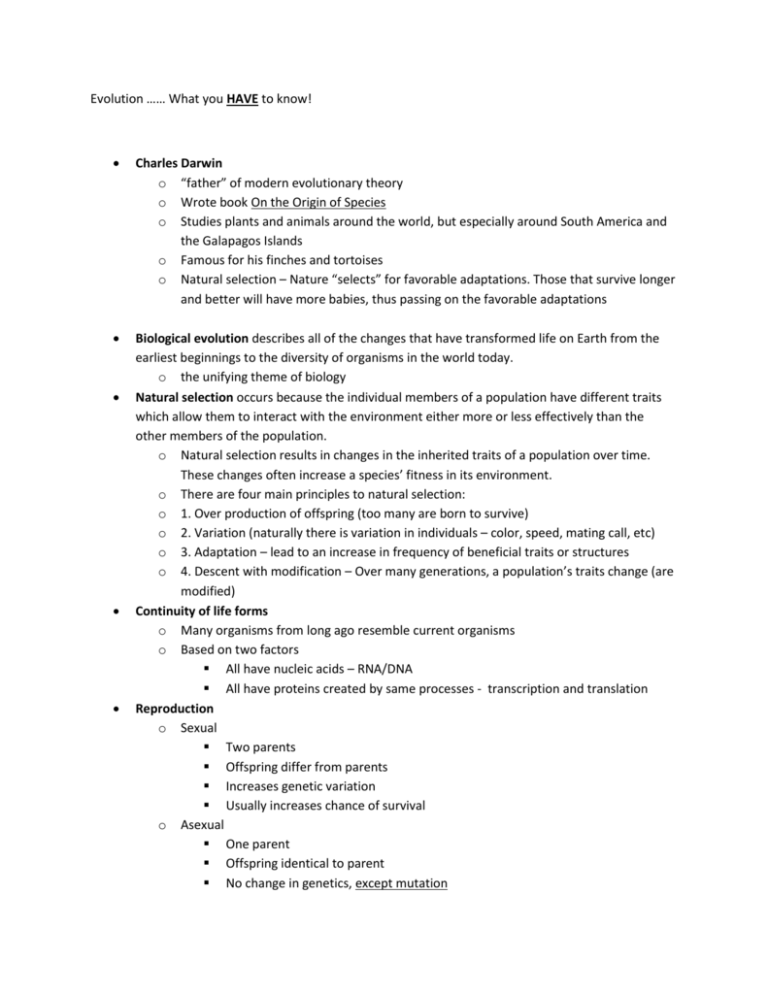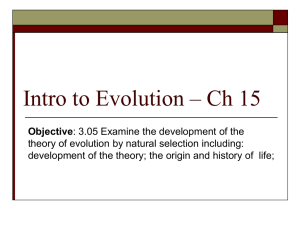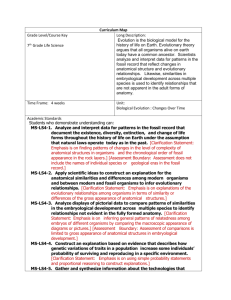Evolution …… What you HAVE to know! Charles Darwin “father” of
advertisement

Evolution …… What you HAVE to know! Charles Darwin o “father” of modern evolutionary theory o Wrote book On the Origin of Species o Studies plants and animals around the world, but especially around South America and the Galapagos Islands o Famous for his finches and tortoises o Natural selection – Nature “selects” for favorable adaptations. Those that survive longer and better will have more babies, thus passing on the favorable adaptations Biological evolution describes all of the changes that have transformed life on Earth from the earliest beginnings to the diversity of organisms in the world today. o the unifying theme of biology Natural selection occurs because the individual members of a population have different traits which allow them to interact with the environment either more or less effectively than the other members of the population. o Natural selection results in changes in the inherited traits of a population over time. These changes often increase a species’ fitness in its environment. o There are four main principles to natural selection: o 1. Over production of offspring (too many are born to survive) o 2. Variation (naturally there is variation in individuals – color, speed, mating call, etc) o 3. Adaptation – lead to an increase in frequency of beneficial traits or structures o 4. Descent with modification – Over many generations, a population’s traits change (are modified) Continuity of life forms o Many organisms from long ago resemble current organisms o Based on two factors All have nucleic acids – RNA/DNA All have proteins created by same processes - transcription and translation Reproduction o Sexual Two parents Offspring differ from parents Increases genetic variation Usually increases chance of survival o Asexual One parent Offspring identical to parent No change in genetics, except mutation Disadvantage if there is a negative trait because it automatically gets passed on Mitosis (cell division) Binary fission (bacteria reproduction) Species o A group of organisms that share similar characteristics and can interbreed to produce fertile offspring. Species that interbreed share a gene pool Genetic change in one organism can lead to change in gene pool If the change increases fitness, then it will gradually become more common in the population Survival – organisms that have phenotypes which are well suited to their environment will be able to survive and reproduce and thus pass on the favorable trait to their offspring. o Favorable traits – coloration, odor, speed, strength, size, etc… Change in genetic variability o Genetic drift – random change in frequency of alleles over time o Gene flow – movement of genes into or out of a population o Non random mating limits frequency of gene expression (in other words, animals CHOOSE their mates, not just random hook up) o Mutation change genetic o Natural selection favors phenotypes that help survival Hardy Weinberg o No change in allele frequency in a species o Doesn’t actually occur in nature o 5 principles of Hardy Weinberg Large population No movement in or out (immigration, emigration) Random mating No mutations No natural selection Patterns of Evolution o Gradualism – gradual change in a species over a long period of time. Example: gradual trend for a smaller body o Punctuated Equilibrium – periods of quick change in a species after long periods of little to no change o Adaptive radiation – a number of different species diverge (split) from a common ancestor o Convergent evolution – organisms in similar environment become similar in appearance and/or behavior (dolphins and sharks) o Coevolution – species evolve in response to each other o Extinction Gradual – slow rate, may be due to climate or natural disaster or human activity Mass – catastrophic event changes environment very suddenly – like a large volcanic eruption or asteroid. Phylogenetic Trees o Diagram that represents the evolutionary history of organisms o Classifies organisms into taxa based on evolutionary relationships o Some phylogenetic trees only show order, not time o o Some also show estimated time of divergence From phylogenetic trees you can determine: Which groups are most closely related? Which groups are least closely related? Which group diverged first? Fields of study and evolution Anatomy o Study of structures o Homologous structures – structures with similar structure (wing of a bird, human arm, dog front leg) o o o o Vestigial organ – structure with little or no function (human appendix, snake hip bones) Phylogenetic tree – often anatomical similarities are used to determine relationships Can be WRONG! For instance, a dolphin and a shark look very similar anatomically, but one is a mammal and the other is a fish, so they aren’t all that closely related. Structures with different evolutionary origin, but similar functions are analogous structures …. Butterfly wing and Bird wing…. Both used for flying (similar function), but one has bones and the other does not (different evolution origin) Embryology o Study of embryonic development of organisms o Compares the anatomies of early stage organism development (pre-birth or pre-hatch) o Similarities in patterns of development can be evidence of common ancestor o Often these similarities will not be seen in adults o Biochemistry o Study of chemical processes in organisms o More similar the DNA (or amino acid sequences), the more closely related the organisms are o Very helpful for organisms that look similar but aren’t really (panda and bear) or those that are similar, but don’t necessarily appear that way (panda and raccoon) o “Molecular Clock” the time since a pair of species has diverged can be estimated Genes evolve at different rates Mutations can be used for comparison Some of this work is “guesstimation”…. We don’t know for sure, we make educated guesses based on the evidence we do have Paleontology o study of prehistoric life o fossil – preserved remains of organisms, usually from hard parts such as shell or bone o fossil record provides evidence of extinct species o o o o Fossil record is incomplete – soft bodies organisms don’t typically leave fossils, fossils only form in certain types of environments, fossils get destroyed over millions of years Older fossils are less similar to modern organism, than younger fossils Index fossil – a fossil common in an area used for comparison Age of fossils Relative dating – does not give an exact age or number, but compares the age of the fossil to another. The deeper a fossil is buried, the older it is (assuming the Earth hasn’t been disturbed) Radioactive dating – (Carbon dating) Use of radioactive isotopes to determine the actual age of a fossil. The amount of the radioactive element (such as Carbon 14) is compared to the nonradioactive form (Carbon 12). Age can be calculated based on the difference.









